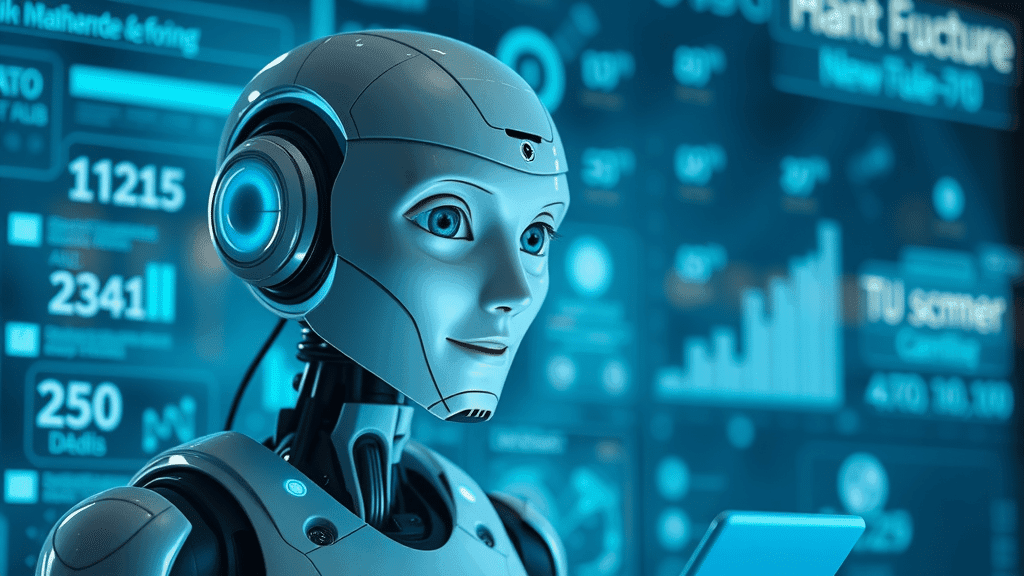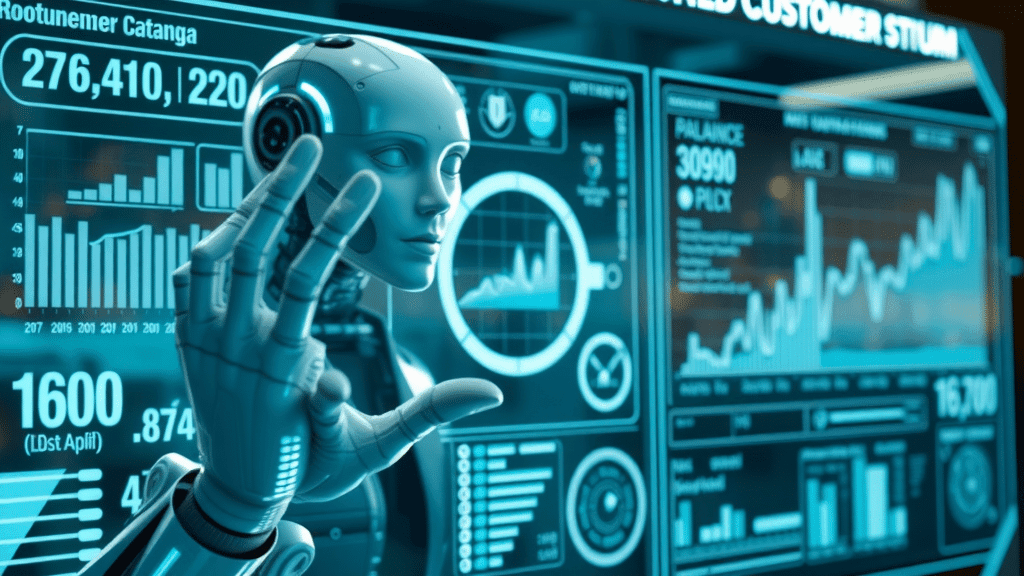Did you know that over 70% of customers expect real-time responses when reaching out for support? In the rapidly evolving digital landscape, automated customer service has emerged as a game-changer—helping businesses reduce costs, improve efficiency, and deliver exceptional customer experiences . If you’re aiming to keep your business competitive, understanding and adopting customer service automation is no longer optional—it’s essential.
Why Automated Customer Service is Revolutionizing Customer Service
- Discover how automated customer service, powered by service automation technology, is reducing costs and boosting efficiency for companies worldwide. Learn why customer service automation is essential for businesses seeking an edge in customer support and experience.

Modern businesses are embracing automated customer service to meet mounting customer expectations and remain agile. With customers demanding instant resolutions and 24/7 availability, traditional approaches often fall short. Service automation empowers companies to provide instant, scalable support while minimizing operational costs and improving efficiency. For example, major retailers deploy intelligent chatbots to resolve order inquiries instantly, while financial institutions leverage automated systems to provide secure account updates in seconds, minimizing wait times and freeing human agents to handle complex issues.
Adopting customer service automation also enhances customer satisfaction by delivering consistent, reliable answers. Businesses of all sizes—from start-ups to global enterprises—are leveraging automation to transform how support teams operate. Those that effectively integrate these technologies with their human service teams see measurable improvements in customer loyalty, lower churn rates, and stronger ROI. As technology continues to evolve, embracing automation isn’t just a trend—it’s the foundation of future-ready customer support.
What You’ll Gain from Mastering Automated Customer Service
- Understand the fundamentals of automated customer service and service automation.
- Identify critical benefits for your customer service and support teams.
- Learn to leverage AI chatbots and knowledge base resources for maximum customer satisfaction.
- Develop best practices for integrating automated customer service with human agents.
By mastering automated customer service , you’ll unlock a multitude of advantages for your business. Learning how service automation works will help you streamline support processes, reduce unnecessary wait times, and ensure that your customers always get the answers they need. You’ll also gain insight into using AI chatbot systems and complete knowledge base solutions, which empower self-service and free up your agents for higher-value interactions.
Moreover, understanding how to blend automation with human expertise is the key to delivering an unbeatable customer experience. Businesses that do this well see higher customer satisfaction rates, stronger engagement, and greater scalability—all while preparing for ongoing advancements in AI and natural language technologies. If you want your support team to thrive, investing in these skills and strategies is a must.
Defining Automated Customer Service: Concepts and Core Elements
The Meaning and Impact of Automated Customer Service

Automated customer service refers to the use of advanced technology—like AI, machine learning, and natural language processing—to manage and respond to customer inquiries with minimal human intervention. These solutions, including AI chatbots and self-service platforms, instantly resolve frequent issues, answer questions, and guide users through troubleshooting without waiting for a live agent. As a result, businesses enjoy faster response times and consistent interactions, while customers appreciate the immediate support.
The impact of service automation is profound. Not only does it minimize operational costs by automating repetitive tasks, but it also scales effortlessly as demand grows. Automated customer service gives support teams the ability to handle thousands of daily requests, enabling human agents to focus on more complex, high-value problems. Companies that adopt this approach report increased customer satisfaction and measurable improvements in metrics like resolution rates and net promoter scores.
How Service Automation is Changing Customer Support
“Automated customer service is no longer a futuristic option—it’s quickly becoming a necessity for scaling exceptional customer support.”
The introduction of service automation has transformed how businesses deliver customer support . Companies now deploy a variety of automated systems, from chatbots handling common questions to sophisticated AI assistants capable of processing transactions and account updates. This evolution ensures round-the-clock availability and reduces error rates, while freeing up valuable staff time. Automated customer service solutions can also integrate seamlessly with traditional support channels, creating an omnichannel experience so every customer interaction is tracked and optimized.
Ultimately, automation allows organizations to offer real-time, personalized, and reliable support, all while gathering valuable data to inform continuous improvement. As hyper-personalization and digital transformation accelerate, businesses that harness the full potential of automation will stand out in crowded markets and set new standards for customer experience .
| Component | Description |
|---|---|
| AI Chatbot | Provides instant answers to customer inquiries |
| Knowledge Base | Centralizes FAQs and self-service support |
| Human Agent Handoffs | Escalates complex issues seamlessly |
| Omnichannel Support | Delivers service across all customer channels |
Automated Customer Service vs. Traditional Customer Service Approaches
Response Times: Real-Time Support Through Service Automation
One of the biggest advantages of automated customer service is rapid response times. AI-powered chatbots and automated workflows handle simple customer inquiries within seconds, far outperforming traditional models that often leave customers waiting for minutes—or even hours—for a reply. Service automation allows support teams to exceed modern customer expectations by providing real-time assistance at scale, no matter the time or channel.
By eliminating delays associated with manual ticket routing, automated customer service makes faster resolutions possible and ensures a positive first impression for every interaction. In turn, this helps build brand loyalty, shapes perception, and increases the likelihood of positive reviews and referrals. Whether addressing common issues or guiding customers to the right self-service resources within a comprehensive knowledge base, real-time automation is setting the new standard for support excellence.
Human Agent vs. Automation: Striking the Right Balance

While customer service automation delivers unmatched speed and efficiency, human agents remain essential for managing complex customer interactions . The most successful support strategies use a hybrid model, allowing automation to resolve basic problems and empowering skilled agents to handle emotionally charged or intricate scenarios that require empathy and problem-solving.
This balance protects the human touch in customer service and ensures customers feel truly understood, particularly when issues can’t be solved by an automated system. Automated customer service can seamlessly hand off conversations to a live agent when necessary, and the combination of automation and human expertise leads to an improved overall customer experience and greater customer satisfaction .
| Feature | Automated | Traditional |
|---|---|---|
| Response Time | Seconds | Minutes-Hours |
| 24/7 Availability | Yes | Limited |
| Consistency | High | Variable |
| Personalization | Improving | Human-led |
Benefits of Automated Customer Service for Customer Experience
Enhancing Customer Satisfaction and Customer Interactions

A standout benefit of automated customer service is its ability to deliver consistent, high-quality support at scale, which significantly enhances customer satisfaction. By reducing wait times, standardizing responses, and ensuring every customer interaction is logged and analyzed, service automation fosters seamless support experiences from start to finish. Customers can access help on their own terms, through their chosen channels—chat, email, or self-service—and receive accurate, timely solutions every time.
These improvements boost not only customer loyalty but also positive word-of-mouth and lifetime value. Automated systems provide detailed analytics on preferences and behaviors, allowing businesses to further tailor experiences and make informed improvements. Over time, the consistency and reliability created by automation position businesses as trusted partners in their customers’ eyes, resulting in tangible growth and competitive advantage.
How Customer Service Automation Drives Business Growth
- Faster response times improve customer satisfaction.
- Consistent and reliable customer support boosts loyalty.
- Customer interactions become measurable and scalable.
When deployed strategically, customer service automation becomes a catalyst for business growth. Automated platforms allow support teams to handle a greater volume of interactions without compromising on quality, thus scaling support operations efficiently. As customer service becomes measurable through robust data collection, companies can pinpoint what works, iterate faster, and proactively address issues—before they impact satisfaction.
This enhanced visibility, paired with operational efficiency, drives cost savings and service quality, directly affecting a company’s bottom line. Brands that embrace automation witness improved retention, elevated customer satisfaction , and an expanded market presence—all while empowering staff to focus on innovation and strategic growth.
Examples of Automated Customer Service in Practice
AI Chatbots: Next-Generation Customer Interaction Tools

AI chatbots are among the most common tools in automated customer service today. These intelligent agents—powered by machine learning and natural language understanding—engage customers instantly on websites, messaging apps, and even SMS. For instance, a retail customer might ask about an order’s status and receive instant, accurate updates via chatbot, rather than waiting in a queue for a live service agent.
Beyond handling simple questions, modern chatbots can schedule appointments, manage account changes, and even resolve payment issues, all without human intervention. This not only enhances scalability and efficiency for your service team, but also provides the consistent, 24/7 support today’s customers demand.
Knowledge Base Systems: Empowering Self-Service
A comprehensive knowledge base is another critical component of effective customer service automation . By centralizing FAQs, how-to articles, and troubleshooting guides, knowledge bases empower customers to find answers independently—significantly reducing the burden on live support teams. Automated systems can direct customers to the most relevant resources, ensuring faster resolutions and fewer repetitive questions for staff.
Well-maintained knowledge base solutions provide real-time analytics on which topics receive the most attention, helping businesses continuously refine their support content. The end result is empowered customers, lower service costs, and a stronger, more resilient support operation that’s always evolving to meet customer needs.
Real-World Use Cases: Leading Brands Leveraging Service Automation
Global enterprises across retail, finance, healthcare, and beyond are already realizing the benefits of service automation . E-commerce leaders use AI chatbot systems to process returns and exchanges seamlessly, while airlines deploy automated kiosks to check passengers in and provide real-time updates. Banks rely on automated phone support and digital self-service channels to answer common questions and enable secure transactions—accelerating response times and drastically cutting operational expenses.
These success stories demonstrate how integrating automated customer service with existing systems leads to enhanced scalability, better customer experiences, and significant competitive advantage. The lesson is clear: early and smart adoption of automation technologies is key to thriving in the digital economy.
Integrating Automated Customer Service with Human Agents
When Human Intervention is Essential in Automated Customer Service
Even the most advanced automated customer service solutions recognize that there is no substitute for genuine human empathy. When customer challenges are emotionally complex or technically challenging, automated systems must escalate cases to a human agent seamlessly. This approach ensures customers feel valued and understood—especially during delicate situations such as billing disputes or product defects.
Whether it’s troubleshooting beyond the knowledge base or handling complaints with a personal touch, human intervention is vital for resolution, retention, and brand image. The smartest systems, therefore, prioritize smooth handoffs and provide agents with rich context, ensuring no customer ever feels abandoned by automation.
Building an Effective Customer Service Team with Automation
“Combining human empathy with AI-driven efficiency creates the ultimate customer service solution.”
The best support teams treat automation and human talent as complementary strengths—AI handles the routine, allowing agents to focus on relationship-building, creative problem-solving, and customer advocacy. By equipping staff with insights from automated systems, companies build a service team that’s more engaged, informed, and prepared for any challenge.
Regular training for both automation and human agent teams ensures that the benefits of technology are fully realized without losing sight of the human dimension. As AI continues to evolve, collaborative approaches will define the future of outstanding customer experience.

AI in Customer Service: Current Trends and Future Outlook
The Role of AI Chatbots in Customer Service Automation

AI chatbots occupy a central role in the automated customer service landscape. Their ability to engage in natural language conversations, learn from interactions, and adapt responses over time makes them invaluable for handling thousands of simultaneous queries at scale. This not only reduces the workload on the support team, but also ensures a consistently high standard of service for every customer.
The sophistication of AI in customer service is improving rapidly, with chatbots now capable of sophisticated intent recognition and even proactive support—offering solutions before a customer voices a concern. As machine learning algorithms continue to advance, the future promises even greater personalization, efficiency, and impact.
Emerging Technologies in Service Automation
Beyond chatbots, new technologies like voice recognition, sentiment analysis, and predictive analytics are expanding the capabilities of service automation . Voice assistants offer hands-free support, while sentiment analysis helps agents and bots tailor responses based on a customer’s emotional state.
Predictive analytics, fueled by AI, enables businesses to anticipate customer needs and proactively offer assistance, further streamlining customer interactions. These emerging technologies are reshaping the support landscape, enabling companies to automate even more complex service scenarios and deliver the hyper-personalized experiences modern consumers expect.
Predictions: The Next Decade for Automated Customer Service
Looking forward, automated customer service will become even more intelligent and deeply integrated into every aspect of customer interaction. AI-driven solutions will predict support needs, resolve issues before they escalate, and build truly frictionless journeys across platforms and devices.
Organizations that invest in continual improvement and agile integration of automation technologies will lead the pack, benefiting from lower costs, higher customer satisfaction , and unstoppable growth. The future is exciting—and automated customer service is the linchpin of success.
Implementing Automated Customer Service Solutions
Steps for Successful Service Automation Deployment
To realize the full promise of automated customer service , businesses must approach implementation strategically. Start by assessing your current support workflows and identifying areas where automation can provide immediate improvements—such as handling repetitive queries or routing common tickets. Next, pilot your selected solutions with clear goals and metrics to track effectiveness.
Ensure seamless integration with existing tools and empower staff with the training and resources to use new systems confidently. Regularly gather feedback from both customers and team members, making iterative improvements as you scale. With the right approach, automation can deliver rapid ROI and lasting competitive advantage.
Evaluating Platforms for Automated Customer Service
With a surge in automation tool options, choosing the right platform is crucial. Prioritize solutions with strong AI capabilities, omnichannel reach, and robust analytics. Evaluate vendors based on proven results, industry reputation, and ease of integration. Look for platforms that support smooth escalation to a human agent and allow customization to align with your unique customer needs.
Don’t forget the importance of customer support during setup and ongoing management—strong vendor partnerships ensure you get the most from your automation investment. Finally, make sure the platform can scale as your business evolves and delivers the security needed to protect sensitive customer data.
- Checklist: Key Considerations Before Integrating Automation
- Assess your support team’s readiness
- Map customer interactions and touchpoints
- Select AI-powered solutions with proven ROI
- Train both automation and human agent teams
Metrics for Measuring Automated Customer Service Success
Tracking Customer Satisfaction, Response Times, and Resolution Rates

Measuring the effectiveness of your automated customer service system is vital for continuous improvement. Start by monitoring customer satisfaction (CSAT), resolution rates, and response times—these core metrics offer insight into the success of both automation and human support. Automated systems also allow for deeper analytics on the volume and types of interactions, helping you identify trends and anticipate challenges.
Tracking these metrics drives accountability across the service team and informs data-driven decisions. Over time, regular analysis ensures your platforms are consistently meeting expectations and delivering ROI, while also revealing opportunities for further innovation.
Continuous Improvement Through Data-Driven Decisions
Automated customer service solutions shine brightest when paired with a culture of continual optimization. By using collected data to monitor evolving customer needs and behaviors, support teams can rapidly iterate, create new knowledge base content, refine AI training, and respond proactively to new trends.
This data-driven mindset empowers organizations to move from reactive to proactive support—anticipating issues, resolving pain points before escalation, and strengthening overall customer engagement .
Overcoming Common Challenges in Automated Customer Service
Maintaining the Human Touch in Automation

One of the greatest concerns about automated customer service is the risk of losing the personal, human touch. To avoid this, businesses must design automated workflows that mimic conversational tone, offer empathetic responses, and never trap users in endless loops. The best systems provide clear options for escalation and regularly seek feedback to improve scripting and interaction quality.
Supporting customers should always feel intuitive and welcoming, even when powered by automation. Regular reviews, customer surveys, and direct agent input help ensure your solution reflects your brand values and meets—or exceeds—customer expectations every time.
Handling Complex Customer Interactions and Escalations
While automation excels at resolving routine interactions, complex issues still require human expertise. Automated systems must be equipped to recognize their limits and escalate appropriately to a skilled human agent . This process relies on training AI to flag sentiment, extract context, and provide agents with detailed conversation histories.
Periodic analysis of escalated cases reveals patterns in what types of issues automation struggles with, allowing teams to update workflows, expand knowledge bases, and train AI models on new scenarios. With this hybrid approach, both customers and staff see the value of automation supported by genuine care and expertise.
- Tips for Avoiding Automation Pitfalls
- Avoid over-automation; recognize limits
- Invest in high-quality AI chatbot and knowledge base
- Regularly review and optimize customer interactions
People Also Ask: What is automation customer service?
Explaining Automation Customer Service: How it Transforms Support
Automation customer service is the use of advanced tools—such as AI chatbots and self-help portals—to provide instant, consistent support to customers with little to no human intervention. These systems streamline operations, reduce wait times, and enable businesses to serve many customers simultaneously, all while freeing up human agents to address more complex or sensitive issues. As a result, customers experience quicker answers and greater satisfaction, while support teams operate more efficiently than ever before.
Ultimately, automation customer service transforms traditional support models by prioritizing speed, scalability, and reliability. It uses a combination of technologies like machine learning, natural language processing, and real-time data analytics to ensure every customer interaction is handled swiftly and accurately—strengthening relationships and reducing operational pressure on staff.
People Also Ask: What is an example of an automated service?
Real-World Automated Customer Service Applications

A clear example of automated customer service is the use of AI-powered chatbots on e-commerce websites, which quickly answer product questions and guide customers through returns or exchanges—eliminating the need for direct human involvement in simple cases. Similarly, automated phone menus in a contact center route callers to the correct department or resolve common issues through speech recognition and pre-set workflows.
Another example is self-service kiosks at airports or hotels, where customers check in, print boarding passes, or get room assignments through an automated system, receiving instant updates and reducing wait times. These examples highlight how automation can make everyday interactions more convenient and empower customers to manage their needs efficiently.
People Also Ask: What is the meaning of automated service?
Defining Automated Service in a Business Context
Automated service in business refers to the use of technology—like AI, software bots, or digital platforms—to perform tasks and respond to customer needs without requiring continuous human intervention. These systems are designed to increase efficiency, accuracy, and scalability while minimizing costs and reducing manual workload for staff.
In a customer service context, automation covers everything from answering repetitive questions to facilitating payments, routing tickets, and providing status updates. The primary goal is to ensure seamless, fast, and cost-effective support that meets modern customer expectations and empowers staff to focus on higher-level challenges.
People Also Ask: What is an automated call center?
Automated Call Centers: Key Functions and Impact
An automated call center leverages interactive voice response (IVR), AI chatbots, and intelligent call routing to handle high volumes of inquiries with minimal need for live agents. These systems answer frequent questions, provide account updates, schedule appointments, and direct complex cases to human experts—ensuring efficient, round-the-clock coverage.
The result is a streamlined operation that drives down costs, reduces wait times, and maintains consistent service quality. Automated call centers enable businesses to grow their customer base without exponentially increasing staff, providing a powerful foundation for scalable support and elevated customer experience .
Best Practices for Maximizing Automated Customer Service
Balancing Automation and Human Touch for Superior Customer Service
Achieving the right balance between technology and personal interaction is key to outstanding customer service . Successful businesses ensure that automated solutions are seamlessly integrated with live agent support, allowing for smooth transitions and always prioritizing customer needs. Building robust feedback loops, where both agent and customer input inform automated workflows, ensures your system grows smarter and more supportive over time.
Empowering your service team to work in harmony with automation leads to greater job satisfaction and better outcomes for customers—allowing agents to focus on tasks where they provide the most value, such as complex troubleshooting and relationship management.
Continual Optimization of Customer Service Automation
Continuous improvement is critical to maximizing the return on your automation investment. Regularly analyzing support data, soliciting agent feedback, and updating the knowledge base ensure your systems stay relevant and effective. Organizations that foster a culture of innovation and adaptability are best positioned to keep pace with changing customer expectations and new technological possibilities.
By revising scripts, expanding automated offerings, and retraining AI models as needed, you ensure your automated customer service keeps improving, consistently delivering value to both customers and your organization.
- Best Practice Highlights
- Integrate feedback for improvement
- Empower service team to collaborate with AI
- Ensure service automation aligns with brand values
Frequently Asked Questions about Automated Customer Service
How does automated customer service affect customer satisfaction?
Automated customer service often improves satisfaction by providing quick, consistent responses and 24/7 availability. By handling routine requests instantly, customers receive the support they need without lengthy wait times, while human agents can devote more attention to complex issues. This leads to higher overall satisfaction and positive customer experiences.
Can automated service automation replace human agents completely?
While automation greatly enhances efficiency and handles many repetitive tasks, it cannot replace human agents entirely. Emotional intelligence, complex decision-making, and nuanced problem-solving still require a human touch. The best support strategies combine automation with skilled agents for optimal results.
What is the difference between customer service automation and traditional customer service?
Customer service automation uses advanced technologies to deliver instant, consistent support—often without human intervention—while traditional customer service relies primarily on live agents to resolve all inquiries. Automation accelerates responses, lowers costs, and allows support to be scaled quickly. Traditional approaches offer higher personal engagement, typically used for more complex or sensitive cases.
How do I choose the right automated customer service platform?
Choosing the right platform involves evaluating AI capabilities, integration ease, support for multiple channels, robust analytics, and scalability. It’s crucial to consider vendor reputation, security measures, and the availability of escalation features. Select a platform that aligns with your business goals, meets customer expectations, and provides continuous support.
Key Takeaways: The Strategic Advantage of Automated Customer Service for Modern Enterprises
- Automated customer service streamlines customer interactions and support.
- Service automation enhances scalability, efficiency, and response times.
- Successful implementation requires the right balance of automation and human agents.
Position Your Business for Success with Automated Customer Service
- Ready to transform your operation with automated customer service? Assess your needs, explore automation platforms, and begin your journey toward future-proof, efficient customer support today.
Automated customer service is revolutionizing how businesses interact with their clients by leveraging technologies like AI chatbots, interactive voice response (IVR) systems, and self-service portals. These tools enable companies to provide 24/7 support, reduce operational costs, and enhance customer satisfaction.
For instance, AI chatbots can handle routine inquiries, allowing human agents to focus on more complex issues. IVR systems efficiently route calls, ensuring customers reach the appropriate department without unnecessary delays. Self-service portals empower customers to find solutions independently, fostering a sense of autonomy and immediacy.
However, it’s crucial to strike a balance between automation and human interaction. While automation offers efficiency, the human touch remains essential for addressing complex or sensitive customer needs. Businesses should aim to integrate automated solutions that complement their human workforce, ensuring a seamless and empathetic customer experience.
Incorporating automated customer service solutions can lead to significant benefits, including cost savings, improved efficiency, and enhanced customer satisfaction. By thoughtfully implementing these technologies, businesses can stay competitive and meet the evolving expectations of their customers.



